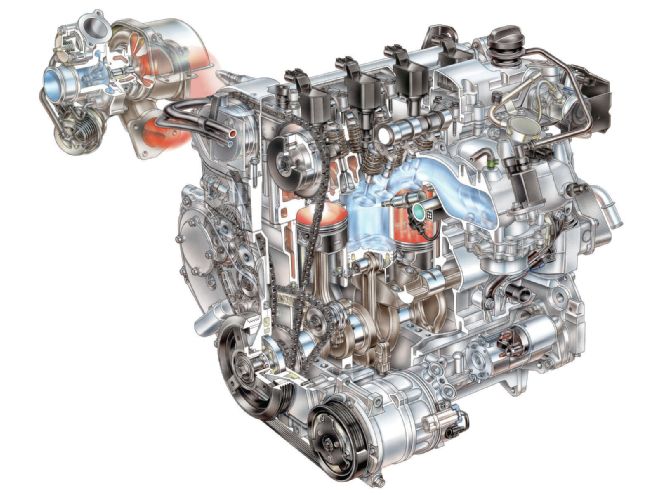
I started driving when the vast majority of cars still had points ignitions. I’ve lived through the mid-’70s transition to electronic ignitions, then 10 years later had to learn a bunch of new tricks in the ’80s, when electronic engine management and port fuel injection (PFI) were introduced. Back then, we bemoaned the apparently complex technology, but milestone cars like the Buick turbo V6 Grand Nationals and Ford 5.0L V8 Fox-bodied Mustangs eventually made us believers. And after years of declining performance, power was again on the upswing—plus, the new cars were cleaner, had better mileage, and were more reliable on a daily basis. Well, here we are in 2013, and there’s another life-altering change on the horizon. It’s called high-pressure direct injection (DI) for spark-ignition engines, and while the transition will be rough at first for hot rodders, the end result will be cars that are faster than ever.
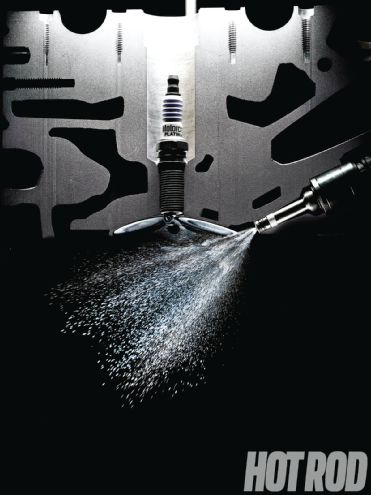
What is DI?
Up to now, the fuel injectors on a spark-ignition engine’s PFI system have injected the fuel into the intake manifold’s runners. In contrast, DI places the fuel injectors directly inside the cylinder head’s combustion chambers. Diesel engines, of course, have always used DI, originally mechanical and now electronic. Much of the basic technology pioneered on modern diesels can be transferred to a DI spark-ignition engine. But there’s one big difference: In a diesel, the air/fuel mixture autoignites from the high combustion pressures induced by those engines’ extremely high static compression ratios; on a spark-ignition engine, the mixture is ignited by an electrical spark. In the past, DI wasn’t feasible or economical for production spark-ignition engines. But ever-accelerating computer power and advances in injector and ignition technology changes the ball game. It lets engineers precisely control the injector firing point, coordinating with the piston’s position in the cylinder. The result is better control over spark timing along with a perfect, homogenous fuel-dispersion pattern. It’s even possible to inject multiple fuel pulses during the four-stroke cycle to achieve the most efficient burn using the least amount of fuel possible. “We see spark knock and performance benefits from two to three injection events per firing stroke,” explains GM combustion specialist Rick Davis.
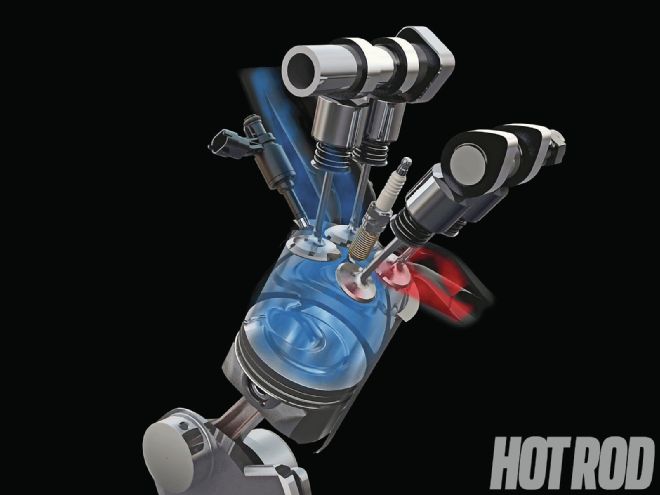 This is the future of performance. As seen here on Ford’s twin-turbo EcoBoost V6, direct injection (DI) for spark-ignition engines delivers precise amounts of fuel directly into the combustion chamber. DI combined with turbos provides big power and efficiency increases, allowing smaller engines to meet or exceed the power levels of larger displacement engines.
This is the future of performance. As seen here on Ford’s twin-turbo EcoBoost V6, direct injection (DI) for spark-ignition engines delivers precise amounts of fuel directly into the combustion chamber. DI combined with turbos provides big power and efficiency increases, allowing smaller engines to meet or exceed the power levels of larger displacement engines.
Why is DI Needed?
We won’t beat around the bush here: Detroit is not going to DI because it wants to but because it has to. Gas mileage must double over the next decade, even as emission regs get ever tougher, and engines will have to get smaller. If manufacturers want to maintain (and perhaps, in time, even increase) performance over today’s offerings while meeting the new mileage standards on reduced-displacement engines, DI appears to be one major component for meeting these goals.
What about Emissions?
In regards to the emissions side, GM says DI should enable compliance with upcoming tougher standards without more add-ons like secondary air-injection systems that would have to be implemented if conventional PFI was to remain viable long-term. For example, one area the feds keep tightening up on is cold-start emissions. Cold-starts traditionally require a rich mixture, and the catalytic converter needs time to light-off; therefore, much of a modern internal-combustion engine’s emissions occur in the first minute or so of engine operation. DI has the potential to improve cold-start mixture control because there’s no liquid fuel puddling in the intake manifold’s runners.
What About Performance?
Here’s where things get interesting. Mileage and emissions considerations may have driven the development of DI tech, but the side benefit is improved engine output over an otherwise equivalent PFI engine.
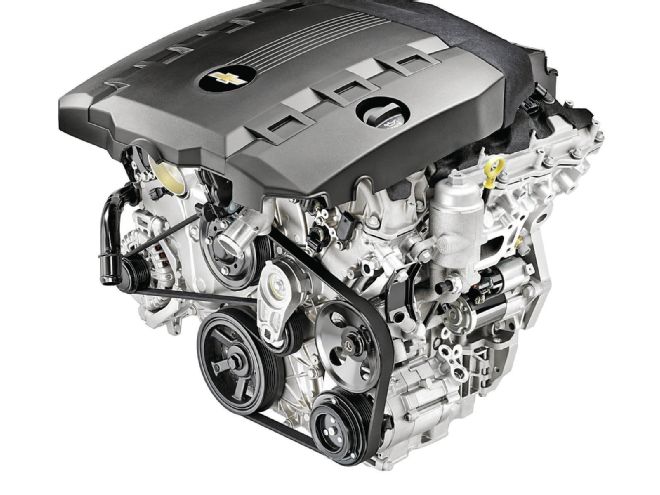 The ’07 Cadillac CTS’s 3.6L High Feature DOHC V6 jumped from 270 to 304 hp when it went to DI in 2008, increasing further to 312 hp in the ’10 Camaro, and as much as 323 hp in the ’12 Camaro—about on par with a ’98 Camaro Gen 3 LS1 5.7L V8.
The ’07 Cadillac CTS’s 3.6L High Feature DOHC V6 jumped from 270 to 304 hp when it went to DI in 2008, increasing further to 312 hp in the ’10 Camaro, and as much as 323 hp in the ’12 Camaro—about on par with a ’98 Camaro Gen 3 LS1 5.7L V8.
It takes heat to vaporize gasoline. In a conventional PFI engine in which gasoline is sprayed into the runner or at the valve head, heat is absorbed from those metal surfaces. This tends to raise the temperature of the incoming air/fuel charge. In a DI engine in which the fuel is injected directly into the cylinder, the heat of vaporization comes out of the air trapped in the cylinder. Explains GM’s Davis, “Fuel in a DI system never hits a metal surface, so the effect is to cool down the air substantially. At full throttle, this can significantly suppress spark knock. Running the same regular-grade pump gas on an otherwise equivalent engine, DI allows us to raise the compression ratio 1 to 1.5 points, from 10:1 to 11:1 or even 11.25:1.”
Increasing the compression ratio is in itself worth power, but there’s more to it than just a higher ratio. “We see an important charge-cooling effect at the end of the intake stroke,” Davis says. “Because the charge is cooler, it’s denser, so the VE [volumetric efficiency] is higher. At low engine speeds, around 1,200 rpm, we see a 10 percent VE and torque improvement. There are time scales involved at higher speed, so the gains taper off, but typically they’re still in the 5 to 7 percent range.” When Ford added DI to its 2.0L nonturbo four-cylinder, it yielded impressive gains in what’s normally considered just a grocery-getter engine. Ford’s fuel-metering expert Scott A. Lehto says the ’10 Focus was “rated at 140 hp and 136 lb-ft at 10:1 compression. Our ’13 DI Focus 2.0L has 160 hp and 146 lb-ft running at 12:1 compression on 87-octane gas.” That’s a 14 and 7 percent gain in power and torque, respectively.
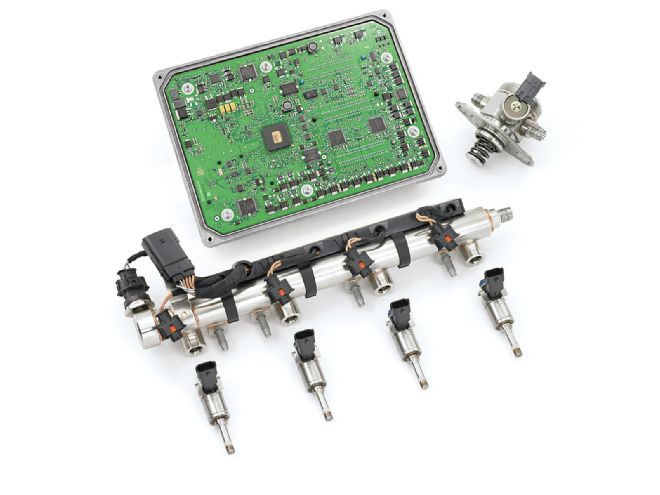 DI hard parts, like these from a GM 2.0L turbo LHU engine, are significantly different from their PFI equivalents. The new computers have a step-up transformer to supply the 60-plus volts needed by the DFI system’s fuel injectors. Also needed is a cam-driven high-pressure fuel pump and fuel rails with a 1⁄8-inch wall-thickness to withstand the high pressure.
DI hard parts, like these from a GM 2.0L turbo LHU engine, are significantly different from their PFI equivalents. The new computers have a step-up transformer to supply the 60-plus volts needed by the DFI system’s fuel injectors. Also needed is a cam-driven high-pressure fuel pump and fuel rails with a 1⁄8-inch wall-thickness to withstand the high pressure.
Higher compression also improves fuel economy under part- throttle load conditions. “We typically see around a 3 percent efficiency gain just due to the higher compression ratio itself,” explains Davis. But from an OE standpoint, there are additional benefits across the total vehicle package. Automakers can maintain performance while further increasing fuel economy by either going to a milder axle ratio or reducing engine displacement by 10 percent.
And then there’s boost. DI engines love turbochargers. Because the DI engine is nowhere near as detonation-prone as a conventional engine, in a pure performance application, Lingenfelter Performance Vice President of Operations Mike Copeland says he’s seen “as high as 18-psi boost on 93-octane gas.” According to Davis, “DI is synergistic with turbocharging. Turbo engines have turbo lag; they need time to spool up. On our dual overhead cam [DOHC] V6 with dual, independent cam phasers, at low speed we can spool up the turbo faster using a scavenging strategy with high overlap, opening the intake and exhaust valves at the same time to scavenge air through the cylinder to increase mass-flow across the turbine wheel. On a PFI engine, you are limited; when you scavenge air you scavenge fuel. But with DI we can scavenge with just air and then wait to inject fuel until the later exhaust-valve closing point.”
Ford’s Lehto adds, “If a turbocharger is used with DI, valve overlap can enable in-cylinder scavenging to purge the cylinders of all leftover exhaust gases—which means more clean air and fuel is used each stroke. That helps the engine deliver more power and torque, especially at the low end.”
Who Has DI Now?
Ford and GM are enthusiastic DI supporters. Besides the nonturbo Focus 2.0L mentioned above, Ford uses DI on all of its turbocharged EcoBoost engines, including the 1.0L three-cylinder, 1.6L and 2.0L fours, and both car and truck versions of the 3.5L V6.
According to Davis, GM “has been a leader in the DI implementation rollout since 2005 in the U.S., across the-board in four-cylinder and V6 engines” because “there’s a huge performance and mileage benefit.” Currently, you’re likely to see DI on GM High Feature V6 family engines including the 3.0L and 3.6 V6, as well as most four-cylinder engines, including the 2.0L turbo, the 2.4L, and the 2.5L. As you read in the story on page 88, GM’s new Gen V V8 features direct injection, which was the impetus for us to research the subject. What Parts Change?
It’s not just the DI computers and software that are different. You’ll be seeing big changes in the hard parts as well. Injecting directly into the cylinder requires much higher fuel pressures than we’re used to seeing on a spark-ignition, PFI system. “The fuel pressure of a vehicle with PFI is between 40–70 psi,” points out Ford’s Lehto. “On a DI car, it is between 2,000–3,000 psi. The higher pressures atomize the fuel better; that helps it mix with the air better.”
High as these DI spark-ignition pressures may seem, it doesn’t hold a candle to the pressures seen on today’s diesels, which get up to 30,000 psi or more. But even at 2,000 psi, a second high-pressure, engine-driven fuel pump is needed in addition to an in-tank pump. Copeland says that, similar to modern diesels, the in-tank pump now serves merely to lift the fuel up to the injection pump, “and that pump supplies the actual fuel. Most are driven off the front of the cam.”
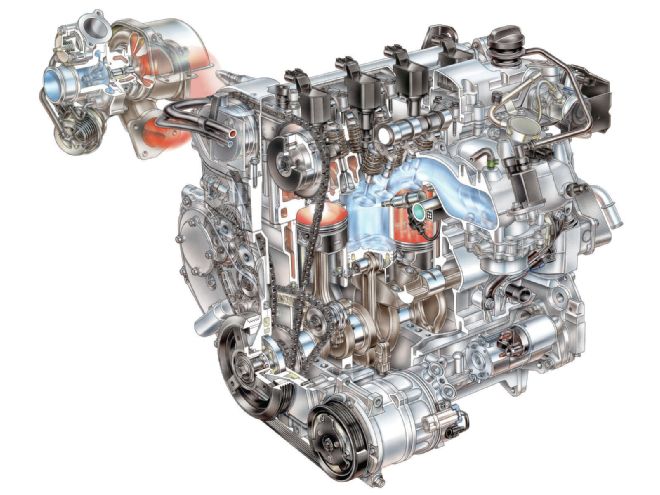 The GM Ecotec Gen II 2.0L (122 ci) engine has DI, a dual-scroll turbo, and continuously variable valve timing for both intake and exhaust valves. Rated under conservative SAE J1349 standards, it pumps out 260 net horsepower. That’s more than 2.13 hp/ci, one of the highest output per cubic inch of any production automobile engine ever! There’s already a factory upgrade package for it.
The GM Ecotec Gen II 2.0L (122 ci) engine has DI, a dual-scroll turbo, and continuously variable valve timing for both intake and exhaust valves. Rated under conservative SAE J1349 standards, it pumps out 260 net horsepower. That’s more than 2.13 hp/ci, one of the highest output per cubic inch of any production automobile engine ever! There’s already a factory upgrade package for it.
The high-pressure pump feeds fuel injectors, injector drivers, and injector solenoids that are completely different from PFI parts. First, they’re much more robust because they actually have to survive inside the combustion chamber with its high temperatures and pressures, all while maintaining a very specific cone angle even while fighting carbon buildup. Second, the solenoid has to open the injector pintle against the high fuel pressure, and that takes more energy. The injectors in a DI system no longer operate at 12 volts; they operate at 60–65 volts! Which means, third, there is now a step-up transformer inside the computer to increase voltage and drive the injectors.
To correctly time the multiple injector pulses, a new crank sensor is added to keep track of the exact position of the piston in the cylinder. The new DI pistons themselves have a cup for directing fuel toward the spark plug. Combine all of the above, and a more powerful ignition system is needed. As Copeland explains, “When you create a high-pressure, highly contained bowl in the piston to light off the spark, you have the same issue that you have when running nitro as a fuel: It will blow the plugs right out because of all that pressure and amount of fuel in a small space. So you must increase the spark energy tremendously. That requires better coils, ignition wires, and spark plugs. Energy is relevant to rpm—you have to consider the coil discharge rate. It’s not a major problem at 3,000–4,000 rpm, but at higher rpm, coil saturation time goes out the window.”
Many DI engines run tighter spark-plug gaps than we’re used to seeing on a production engine. Spark-plug design itself is basically conventional, but downsized to 10 or 12 mm to gain real estate. After all, the combustion chamber needs to accommodate the DI injector as well as the spark plug. With their symmetrical chambers, four-valve DOHC engines seem to be best suited to DI.
Popular in North America, “side-injection” DI architecture—which places the injector on the side of the chamber under the intake port between the two intake valves—requires only minimal changes in the cylinder-head architecture, the location of the cams, or the water-jacket configuration. There’s also “central injection” DI where the injector is centered in the cylinder adjacent to the spark plug. That requires lots of changes to the cylinder head, and is presently more popular in Europe, where stratified-charge/lean-burn systems are the norm to meet that continent’s emissions standards.
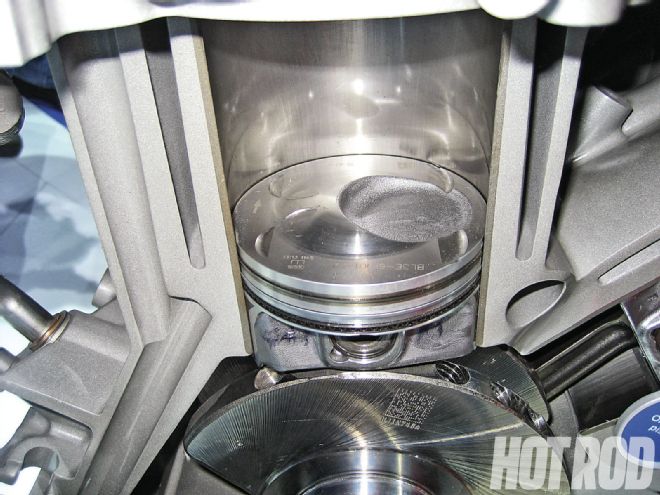 The pistons in a DI engine typically have a bowl to direct some of the DI fuel spray toward the spark plug and injector. This makes the area near the plug slightly richer, enhancing cold-start performance. This piston is used on the Ford 3.5L V6 EcoBoost engine.
The pistons in a DI engine typically have a bowl to direct some of the DI fuel spray toward the spark plug and injector. This makes the area near the plug slightly richer, enhancing cold-start performance. This piston is used on the Ford 3.5L V6 EcoBoost engine.
Adopting DI for a two-valve pushrod engine with its asymmetrical chamber layout is difficult. Where should the injector point for developing the optimum air/fuel mix? There’s lots of work needed to determine how to generate the proper swirl, tumble, and spray characteristics. Because of cooling issues, the injector can’t be on the exhaust side—but on the intake side, the pushrods are in the way. The water jacket requires redesign to ensure adequate cooling under the different thermal loading induced by DI. All this makes it impractical to retrofit DI onto an existing two-valve engine (which is why GM’s Gen V has a completely new head specifically optimized for DI).
Can DI Be Hot Rodded?
DI is already being run in professional racing. A Chevrolet 2.2L, DI, twin-turbo V6 is the dominant engine in the IZOD IndyCar race series, winning 11 out of 15 races in 2012, competing against Honda and Lotus. In its current incarnation, the series specifies E85 fuel, and the amount of fuel that can be used is limited. Under these constraints, a DI race motor offers similar efficiency gains and fuel-economy benefits just like its pedestrian production counterparts. The special DI parts capable of supporting this kind of power were developed for the most part by the same vendors that supply DI parts for GM production engines.
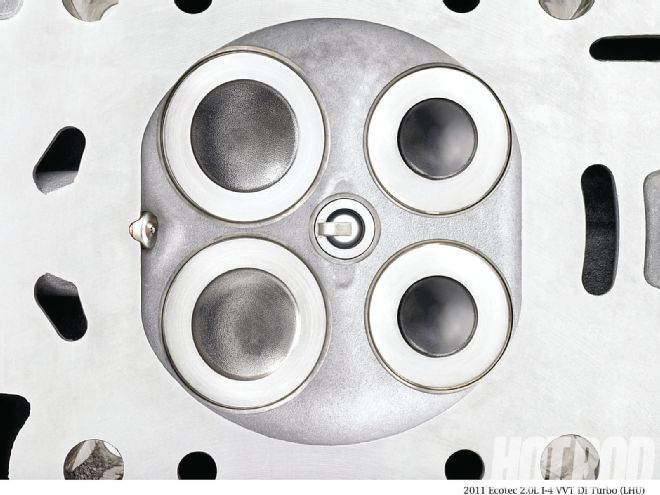 So far, DI is mostly seen on four-valve, DOHC engines. “It’s easier to do on a four-valve engine where the chamber is symmetrical,” maintains GM’s Davis. In the U.S., the most popular approach is “side-injection” DI architecture, seen here (injector, arrow) on the GM 2.0L DOHC L4 turbo-engine head. This approach requires only minimal changes to the head configuration.
So far, DI is mostly seen on four-valve, DOHC engines. “It’s easier to do on a four-valve engine where the chamber is symmetrical,” maintains GM’s Davis. In the U.S., the most popular approach is “side-injection” DI architecture, seen here (injector, arrow) on the GM 2.0L DOHC L4 turbo-engine head. This approach requires only minimal changes to the head configuration.
Intended for production-based professional and road-racing classes, Ford Racing has developed the ’12 Ford Focus ST-R package car (PN M-FR200-STR). Power comes from a hopped-up turbocharged 2.0L EcoBoost four-cylinder. It joins Ford’s family of turnkey Mustang race cars. You can purchase an ST-R complete from selected vendors, but it’s not street-legal.
As to more street-oriented hot rod parts, just as with the ’80s introduction of PFI, there’ll probably be a slight lag until the aftermarket gets up to speed on DI. It helps that much DI tech is similar to today’s high-tech diesels, for which there is already plenty of aftermarket support. The OEs may also jump-start the hop-up movement by introducing their own enhanced performance parts just like GM did for the small-block Chevy back in 1955. Already Chevrolet Performance Parts has a performance upgrade kit (PN 19212670) for the ’07–’10 Cobalt SS and ’07–’09 Pontiac Solstice GXP and Saturn Sky Redline that bumps up its stock 260 hp/260 lb-ft rating to 290 hp/340 lb-ft without violating the new-car warranty. Mostly, the kit is all in the “brain”: a dealer computer reflash plus a new MAP sensor that can cope with the higher turbo boost generated by the new calibration. GM is said to be developing stage kits for the four-cylinder DI cars similar to their earlier stage kits for the supercharged 2.0L Ecotecs. There are even rumors of DI Gen V crate engines in the pipeline.
The GM-style stage kits that include specifically qualified parts for selected models probably will set the pattern for aftermarket DI hot rod parts. After all, many DI parts are application-specific; for example, the injectors are not universal, as they are for PFI engines, but instead are designed only for the intended application.
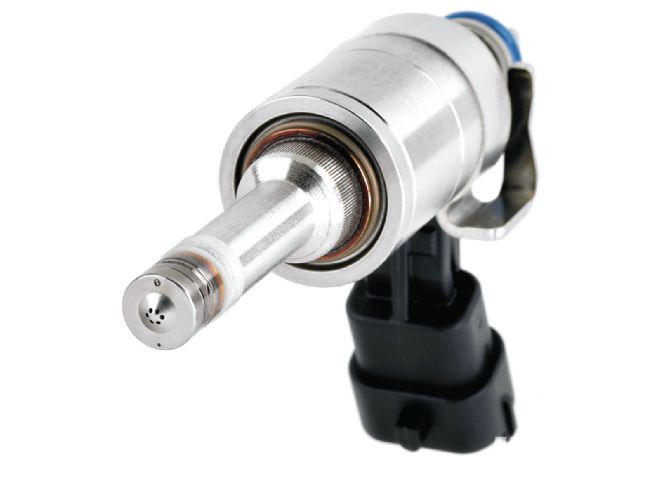 A 60-volt DI injector has a hardened, stainless-steel needle with internal clearances measured in microns. They have to survive 1,500-degree F combustion chamber temps. Each injector design’s conical spray pattern must be carefully matched to the piston shape and chamber design, so the injector is application-specific.
A 60-volt DI injector has a hardened, stainless-steel needle with internal clearances measured in microns. They have to survive 1,500-degree F combustion chamber temps. Each injector design’s conical spray pattern must be carefully matched to the piston shape and chamber design, so the injector is application-specific.
Currently, no larger injectors are available to the general public. Existing stock injectors have a tighter dynamic range than OE PFI setups, typically operating at an 85–90-percent duty cycle to meet power and idle-quality goals. Their spray pattern is tailored to the overall combustion-chamber configuration to ensure proper operation. Collectively, this means the existing injectors that came on the car have limited room for growth. On the other hand, it may be possible to re-program the computer to raise the fuel pressure, or even (in a non-emissions implementation) use a larger belt-driven fuel pump. However, Copeland maintains that “a bigger in-tank pump won’t increase the pressure up front” because it’s basically a priming and transfer device. At least on the computer front HPTuners already has publicly available software for reflashing selected GM DI computers, including the 2.0L four-cylinder turbos. SCT has programming for many Ford DI platforms.
Hot rodders have only just started on the learning curve with this new technology. It may seem scary at first, but look how much better PFI engines now run compared with their carbureted counterparts. Imagine the dual-purpose potential of a turbocharged DI-engine with variable cam timing and selective cylinder deactivation. Brace yourself for the next evolution of automotive performance. Hot Rod
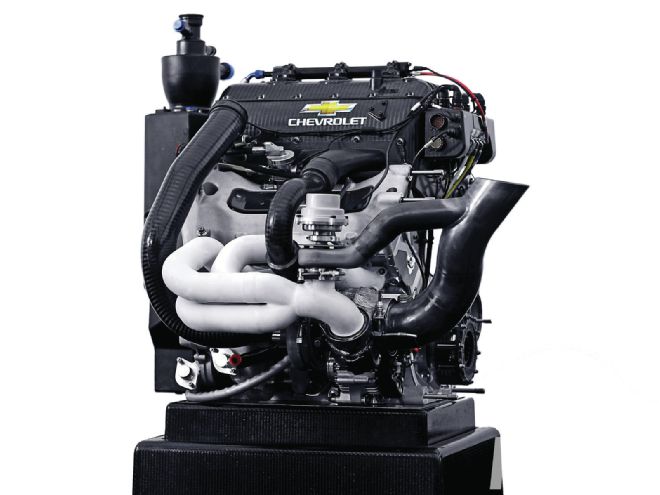 Running E85 fuel, Chevy’s 12,500-rpm, 2.2L DI twin-turbo V6 dedicated IndyCar-series racing engines make 500–700 hp, depending on the amount of boost, which varies per the type of track. Nothing interchanges between the Indy motor and GM V6 production engines, but it does showcase the hardcore potential of a racing DI system.
Running E85 fuel, Chevy’s 12,500-rpm, 2.2L DI twin-turbo V6 dedicated IndyCar-series racing engines make 500–700 hp, depending on the amount of boost, which varies per the type of track. Nothing interchanges between the Indy motor and GM V6 production engines, but it does showcase the hardcore potential of a racing DI system.
What’s the Downside?
Chrysler hasn’t yet embraced DI. Director of Advanced and SRT Powertrain Chris Cowland says, “There’s a trade-off: DI could add 15 percent to the material cost of the engine. The extremely high fuel pressures are mechanically noisy, plus the pulsations that open the injectors create mechanical noise. Extra noise-reducing packages must be put on the vehicle, which adds additional cost plus some weight. It also takes additional friction to pump up the fuel to 2,000 psi.
“If you compare fuel consumption from our Pentastar 2.6L V6 to a GM DI V6 engine, we think we are pretty competitive from a fuel-economy perspective, without the noise or cost problems. We think PFI will still be around for five to eight years. In that time, DI noise, friction, and cost issues should improve. Of course, we are continually reassessing DI engines.”